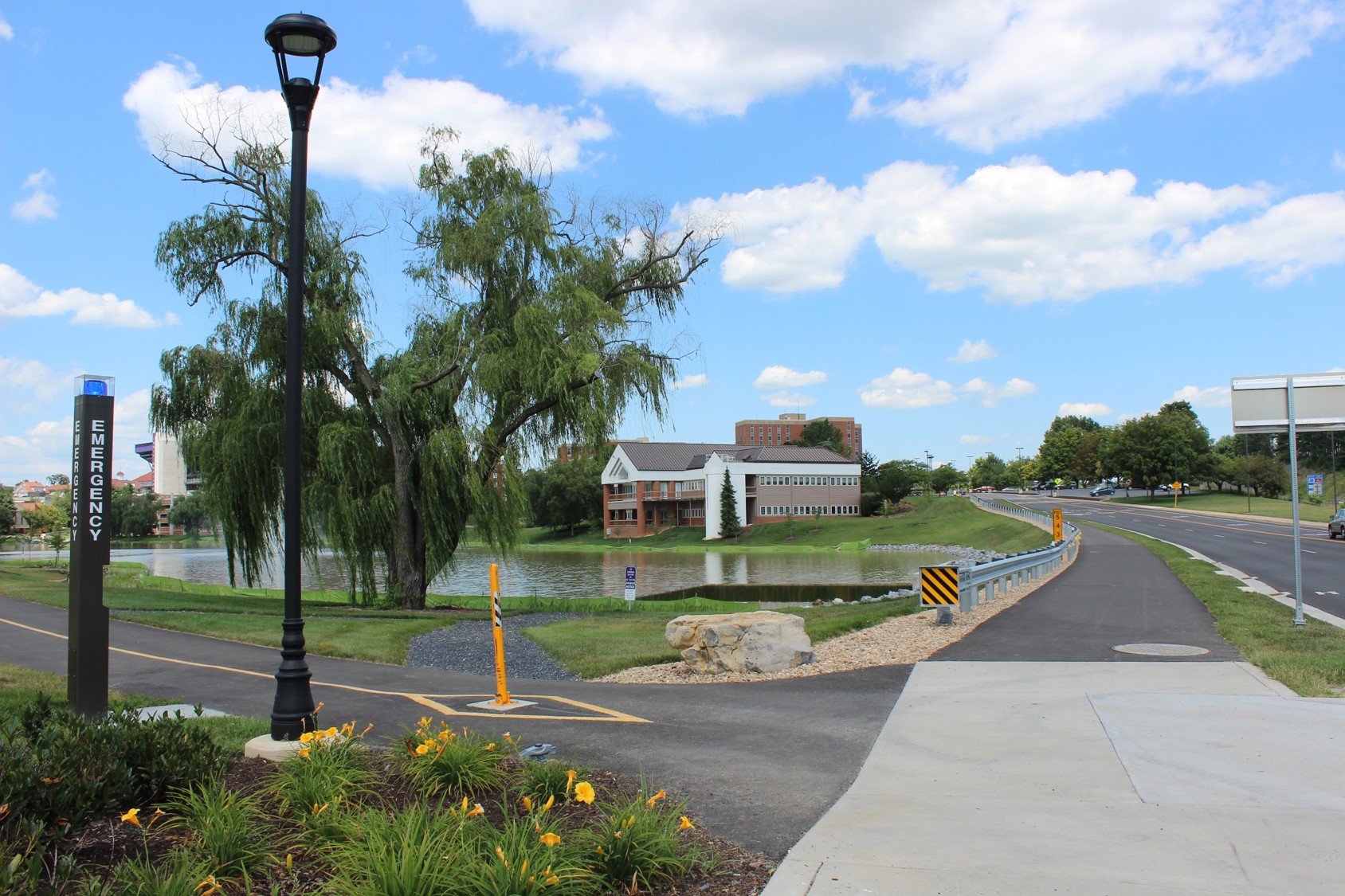Better Together: JMU and City of Harrisonburg Collaborate to Make Bicycle and Pedestrian Improvements
News
Construction continues on the Bluestone Trail—a shared use greenway that offers safer passage for bicyclists and pedestrians through campus and surrounding areas.
Originating south of the JMU campus, the trail extends north from Stone Spring Road through Purcell Park and onto the JMU campus at Bluestone Drive. Upon entering campus, one branch of the path extends to Greek Row, while the main branch proceeds past Newman Lake. Ultimately, the Bluestone Trail will connect with the in-progress Northend Greenway, extending to the downtown farmers market and to Eastern Mennonite University. This will allow people to safely bike or walk from one end of the city to the other.
The completion of the first segments of the Bluestone Trail marks the realization of several years of planning and collaboration between JMU and the city of Harrisonburg. Lee Eshelman, transportation demand manager at JMU, organized and served as chair of the Bicycle and Pedestrian Advisory Committee (BPAC) beginning in December 2012.
The BPAC served as the driving force behind the development of the JMU Bicycle and Pedestrian Master Plan. “I set up the BPAC to get people together who had the experience and the interest to actually develop the master plan,” says Eshelman. The BPAC committee attracted 18 people from diverse backgrounds, including JMU faculty, staff and students; city of Harrisonburg employees; and local downtown business owners.
Developed over the course of one year, the master plan outlines several multimodal transportation projects and program development recommendations for implementation at JMU and in the city.
“We held several outreach sessions for the community,” Eshelman recalls. “We put maps up on easels and let people mark where they thought bike lines should be, or where improvements were needed for better pedestrian safety. We got a lot of input from the citizens in the open-house sessions. One of the underlying themes was interconnectivity with the city.”
The consulting firm VHB guided development of the master plan in collaboration with the BPAC committee.
“We had previously done a good deal of work with JMU on other projects, and when we saw this opportunity to work with the university on a bicycle and pedestrian plan, we were very excited,” explains Chris DeWitt, principal with VHB and lead consultant on the project. “We spent a lot of time on campus, both during the school session and during the summer to see changes in use patterns. We did a lot of photo documentation and a lot of pedestrian touring to see where the gaps were and what facilities were there.”
VHB developed and modifed the "JMU Moves" mobile app to aid in the data collection process. "It’s a free app that records your trip, maps your route and shows your speed and travel time,” explains DeWitt. “We mapped all the output from the app and showed that to the BPAC, and that helped the committee and VHB see where there was a need.” Even though the data collection process is over, students can still download the app for personal use.
The collaboration involved in the master plan development and the Bluestone Trail's construction has not gone unnoticed in the community. Thomas Jenkins, co-owner of Shenandoah Bicycle Company in downtown Harrisonburg has been impressed by the collaboration he's seen thus far. “The phase of Bluestone Trail . . . [it] couldn’t have happened without good communication from both entities, JMU and the city,” he says.
Part of the success with the Bluestone Trail project is the multiple benefits for both the community and the JMU campus. “The goal is to get more people biking and walking,” says Jenkins, who is also a member of the BPAC.
Thanh Dang, Harrisonburg’s transportation and environmental planning manager, observes that there has been a growing demand for alternative transportation routes in the community. “That’s not something we’ve had in the city before,” she says, “and as people travel elsewhere they start to see that other places have these types of trails and they ask, ‘why can’t we have something like this here in Harrisonburg?’”
Having a plan in place is merely the first step in continuing to cultivate a culture of biking and walking on the JMU campus and in the Harrisonburg community. The BPAC, as well as the Shenandoah Valley Bicycle Coalition, partner with JMU and the Harrisonburg-Rockingham Metropolitan Planning Organization (HRMPO) to present the annual Bike-Walk Summit. Now in its fourth year, the summit meets on the JMU campus and focuses on a different topic related to biking and walking each year.
Rich Harris, JMU’s director of community service learning and BPAC representative, helps to organize the Bike Walk-Summit. “We thought it would be good to have some type of gathering where we picked a topic that we don’t know as much about as we’d like to, and then get the decision makers—elected governmental officials and staff of the appropriate agencies for transportation planning—together with biking and walking advocates, get them in the same room to hear the same message and once they’ve heard that message ask, ‘Where can we find ways to work together to make some of these things happen?’”
The 2015 summit will be held Nov. 13 at JMU and will focus on keys to building a successful biking and walking community. More information is available on the Shenandoah Valley Bicycle Coalition website.
Other projects in the JMU Bicycle and Pedestrian Master Plan will be completed over the next several years. Although the full plan is far from being a realized dream, it already has helped both JMU and the city to pave the way for safer biking and walking in Harrisonburg.
Story and photograph by Katelyn Quinley ('16M)

